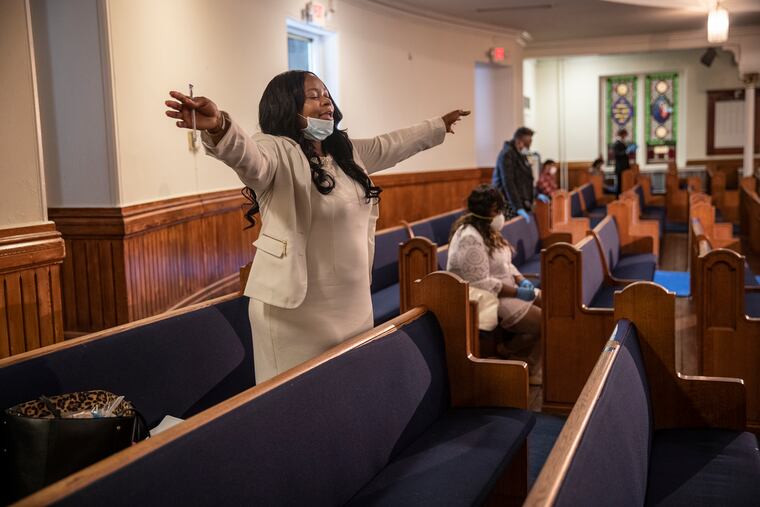Most rate Trump’s coronavirus response negatively and expect crowds will be unsafe until summer, poll finds
Most Americans expect no immediate easing of the health risks associated with the coronavirus pandemic, despite calls from some to begin reopening the economy quickly.

Most Americans expect no immediate easing of the health risks associated with the coronavirus pandemic, despite calls by President Donald Trump and others to begin reopening the economy quickly. A majority say it could be June or later before it will be safe for larger gatherings to take place again, according to a Washington Post-University of Maryland poll.
Most Americans — 54% — give the president negative marks for his handling of the outbreak in this country and offer mixed reviews for the federal government as a whole. By contrast, 72% of Americans give positive ratings to the governors of their states for the way they have dealt with the crisis, with workers also rating their employers positively.
Partisan allegiances shape perceptions of when it will be safe to have gatherings of 10 or more people and of the president's performance during the pandemic. But governors win praise across the political spectrum for their leadership, which has sometimes put them sharply at odds with Trump and his administration.
Personal health concerns are widespread, with 57% saying they are "very" or "somewhat" worried about becoming infected and seriously ill from the coronavirus, including at least 40% of people in every major demographic and political group. For those most concerned, the fear was enough to override partisanship when it comes to the safety of public gatherings, particularly for Republicans.
Disruptions caused by the coronavirus outbreak continue to ripple through households across the nation, with businesses and schools closed and most Americans being urged to stay at home. About 7 in 10 adults, and more women than men, say the pandemic has been a source of stress in their lives. Half of all adults say the crisis has produced financial hardship for themselves or members of their family.
Those results are almost identical to findings from a Post-ABC News survey of a month ago and a more recent CNN poll that focused on financial hardship.
The latest Post-U. Md. poll finds that about 1 in 3 Americans are concerned about their household being able to pay bills over the next month, while a similar percentage are concerned about affording food and basic household items. Some 48% of Hispanics are concerned about affording food or other basic items, as are 39% of blacks and 23% of whites.
"I found those numbers alarming," said Michael Hanmer, a professor of government and politics at the University of Maryland who codirected the survey. "There's a big gap between whites and nonwhites for financial hardship and particularly when you get into paying the bills."
A rapidly growing share of Americans have personal connections to the outbreak's victims. The poll finds that 26% of adults know someone who has been diagnosed with the coronavirus, up sharply from 11% in mid- to late March. Today, 14% report knowing someone who has been hospitalized because of the virus, while 9% know someone who has died of it.
The nationwide survey among a random sample of 1,013 adults was conducted during a week in which demonstrators in multiple states protested stay-at-home orders and restrictions on business activity, and were encouraged by Trump's tweets to "LIBERATE" Minnesota, Michigan and Virginia, where demonstrations were held.
Yet in contrast with that overt pressure to reopen the country, the poll finds a clear majority of Americans expect social distancing practices will be necessary until at least the beginning of the summer.
Asked when people expect the outbreak to be controlled enough that people can safely attend gatherings of 10 or more people, just 10% predict such gatherings would be safe by the end of April or earlier, while another 21% expect them to be safe by the end of May. More than twice as many — 65% — say it may take until June or later for people to safely gather in groups of 10 or more.
Partisans divide on this question, with 77% of Democrats and Democratic-leaning independents saying they expect public gatherings will not be safe until June or later, compared with 51% of Republicans and Republican leaners who say the same. Yet Republicans split depending on personal health concerns.
Among Republicans and Republican-leaning independents who are less worried about becoming infected and seriously ill from the coronavirus, 60% expect public gatherings will be safe by the end of May or earlier. But among Republicans who are at least somewhat concerned about becoming seriously sick, 66% say this will take until June, not far from the share of all Democrats who anticipate such a delay.
» FAQ: Your coronavirus questions, answered
Americans are also pessimistic about how quickly the economy will recover after the outbreak is under control. A 63% majority expect the economy will recover slowly, while 37% think it will recover quickly. Trump has predicted a rapid recovery once businesses reopen, and his optimism is shared by 55% of Republicans. Most independents and Democrats expect a slow recovery.
In the meantime, Americans are actively taking part in measures meant to stem the spread of the virus. Most — 65% — report wearing a mask or a face covering when leaving home in the past week. Another 17% say they did not leave home at all. Democrats are more likely than Republicans to say they had worn a mask or not left home at all.
The poll was conducted by The Washington Post and the University of Maryland's Center for Democracy and Civic Engagement. Interviews were conducted April 14-19 among a random national sample of 1,013 adults, 69 % of whom were reached on cellphones and 31 % on landlines. Overall results have a margin of sampling error of plus or minus 3.5 %age points.
The Washington Post’s Emily Guskin and Alauna Safarpour contributed to this article.